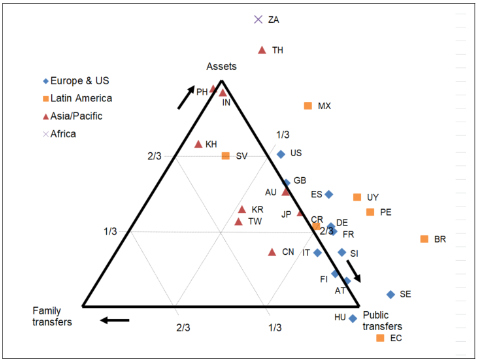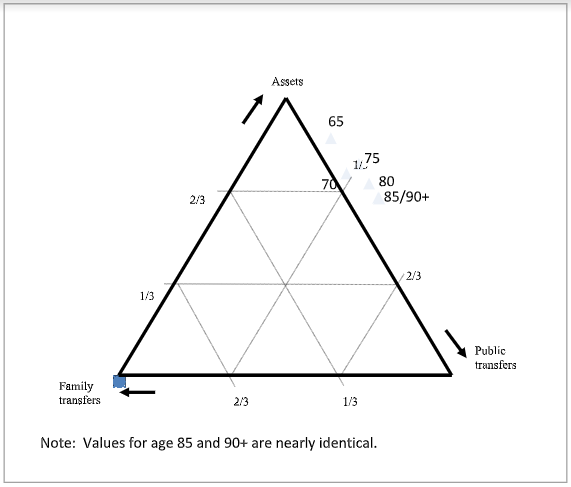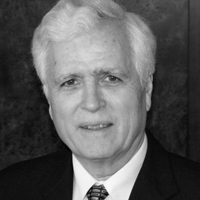Intergenerational Transfers in the United States

In all contemporary societies, seniors are consuming more than they are producing through their labor. The resource gap, what we call the “lifecycle deficit”, is funded through a combination of three possible
mechanisms. First, seniors may rely on private intergenerational transfers that flow predominantly from family members who are often co-residing. These transfers could be financial, but they may also be in-kind including the value of shared housing and meals or unpaid time devoted to caregiving. Second, seniors may rely on net public transfers, that is the value of public transfers received less taxes paid by the elderly.
In high-income countries, public pensions and publicly funded health care are the most important forms of public intergenerational transfers to the elderly. Third, seniors may fund old-age needs by relying on asset income or dis-accumulating assets acquired at younger ages. Seniors may own their own home, they may have funded pensions accumulated during their working years, or they may own a business or a farm.
The mechanisms for funding old-age lifecycle deficits are quantified using the “triangle graph” shown in Figure 1. The graph shows the shares of the old-age deficit funded via private transfers, public transfers, and asset-based reallocations (asset income plus dis-saving). A point located at any vertex indicates that the mechanism as labelled funds 100 percent of the old-age deficit. India and the Philippines, for example, rely exclusively on assets to fund the deficit while Hungary relies exclusively on public transfers. Along any edge, countries rely on two mechanisms of support. Many countries rely on a combination of assets and public transfers and not on familial transfers.
Figure 1. Share of life cycle deficit for those 65 and older funded by public transfers, family transfers, and asset-based reallocations, selected countries.

In many countries net family transfers are negative – seniors are providing more to younger family members than they are receiving. Many of these countries are in Latin America. Seniors in Peru,
Uruguay, and Brazil, for example, receive substantial public transfers but are redistributing those to their children and grandchildren through familial transfers.
Intergenerational transfers in the United States are the focus of this project. In 2003, the year for which US data are compiled in Figure 1, elderly relied heavily on assets to fund the old-age deficit. Two of every three dollars used was funded through assets and about one of every three dollars was funded through public transfers. The US is unique as compared with other high income countries in its heavy reliance on assets and its low reliance on public transfers to fund old-age needs. Among most European countries, public transfers funded at least two-thirds of the lifecycle deficit of the elderly.
One of the important features of the cross-country triangle graph is the strong tradeoff between asset-based reallocations and public transfers. But more detailed analysis will allow us to look at how the support system evolves over time and varies across age. Estimates for the US 2003 by single year of age again show a strong tradeoff between asset-based reallocations and public transfers (Figure 2). At age 65 asset-based reallocations dominate at 86 percent of the lifecycle deficit. By age 70, asset-based reallocations have declined and been replaced by public transfers. The strong tradeoff between asset-based reallocations and public transfers continues for seniors in their mid-seventies and older.
Figure 2. Share of life cycle deficit funded by public transfers, family transfers, and asset-based reallocations, seniors aged 65, 70, 75, 80, 85, and 90+, United States, 2003.

As research on this project progresses we anticipate having much more detailed time series data that will allow a deeper understanding of how and why the material needs of seniors are changing as the US population ages.








